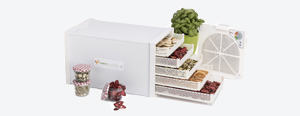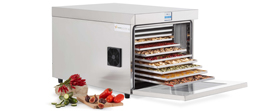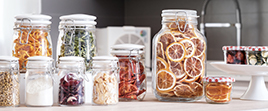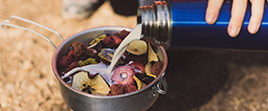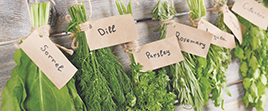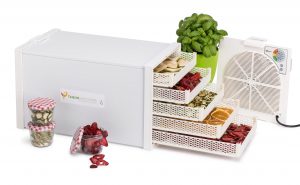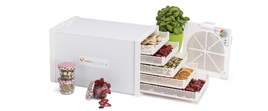Frequently asked questions
How much does my BIOSEC consume?
The BIOSEC engine is specifically designed to optimise consumption in all circumstances and even includes a dedicated energy-saving programme.
From an energy-saving perspective, maximum consumption is only realised when the motor is heating up to the highest limits (e.g. 68° in programme P4) and the fan reaches maximum speed.
At all other times, BIOSEC consumes on average varying amounts ranging from about 15W to 550W, depending on the selected programme and the current phase of the programme.
Does BIOSEC dispose of moisture in my house causing mould?
Under normal room ventilation conditions, the amount of water disposed of by BIOSEC does not lead to any kind of problem with accumulation, mould or expelled moisture.
Are the materials of construction of my BIOSEC safe and certified?
Do plastics contain BPA or phthalates?
BIOSEC is made of the best materials for food use and models made of plastic are free of BPA and phthalates, which could never become harmful at the operating temperatures of a dryer. Every component is CE-certified for food use, and our offices will be happy to send you copies of the documentation to ensure the complete safety and suitability of our products.
Can I use BIOSEC in the open air?
Can I use it in a closed room?
BIOSEC fears the weather and direct exposure to sunlight. For correct use of the dryer, it is best to place it in a sheltered place that is neither too humid (no bathrooms, cellars or laundries) nor too cramped (do not enclose it in places the size of a cupboard) to allow proper air exchange and disposal of moisture. Like all electrical devices then, BIOSEC should be kept away from water.
Is it possible to dry different products at the same time?
Is it necessary to load all BIOSEC baskets?
BIOSEC also works perfectly well with only one full basket; you can fill as many as you wish. However, there is nothing to prevent you from optimising the space by drying different products in different racks. In this case, take care to place the most watery foods at the bottom, choose a programme suitable for all the varieties to be processed and check the degree of drying achieved at different times. You can withdraw the different products as they are completely dried or wait until the entire load is ready. Nothing burns in a dryer, even if you leave it in there longer than it should!
How should a product be stored once it has been dried?
Is vacuum packing compulsory?
No, vacuum packing is not the only solution for storing dried foodstuffs, although it is certainly the one that provides the greatest space savings. It has the drawback of breaking products which, once dried, are more fragile. Glass jars with screw-on or snap-on caps are a perfect alternative; they can be found in all supermarkets, do not require sterilisation and you only have to close them carefully each time you open them. In general, dried products should be stored away from moisture, light and insects and stored in the dark in a cupboard or pantry.
How long can a dried product be stored?
By drying, we obtain a product that can last more than a year if stored indoors and protected from light (e.g. in glass jars in a cabinet).




